I needed to build a cover for my fireplace, to keep the warm air from escaping up the flue. It gets drafty in my house come wintertime, which is probably to be expected given its age. It was built in 1938 and has lathe and plaster walls, old single-pane double-hung windows, and gorgeous oak hardwood floors throughout. Old homes come with quirks and idiosyncrasies, and mine is no exception. In the case of the fireplace, it’s two biggest issues are that it doesn’t draw well and the flue doesn’t open properly.
Doesn’t Draw Well – What is That?!
It has nothing to do with crayons or pencils, but rather with the fireplace’s ability to pull air in (draw) from the room, and push smoke up the chimney. When this is out of whack, you’ll often get smoke pouring out of the fireplace and smoking out your room. Not fun. The problem with the draw seems to be a factor of the firebox size in relation to the opening, the flue, the height of the chimney, and the sign of the zodiac. In my fireplace, I’ve been able to mostly fix this problem by adding a smoke guard at the top of the fireplace opening. This helps most of the time, but I’ve still got issues with the flue and the chimney height.
The Damn Flue
Long story short, when I bought the house, the chimney was in bad shape, and lots of mortar had fallen down the chimney and landed on top of the closed flue. It took a lot of muscle and contortions to get the flue opened, and then clean out the mortar that was piled on top of it. But the hinge is still jacked up, and the flue won’t open all the way, and so for 14 years, the flue has been held open by a brick. Which means that when it’s windy, I get a bit of a downdraft that makes the room smell smoky (even when there’s no fire burning), or when it’s cold and I’m running the furnace, heated air escapes up the chimney.
The Project: Build a Fireplace Cover
I had seen one at a friend’s home, so I had an idea of what I wanted to create. It also needed to be quick, inexpensive and easy, since I don’t have a lot of time or money to invest in the project right now.
Design Concept
A thin piece of wood held against the fireplace with magnets that stick to the metal smoke guard. Paint it black, slap on a couple knobs, and fill the gap with weather stripping. Nothing fancy, but it will get me through the winter.
What You’ll Need
- Wood – I used 1/4″ plywood, but you can use whatever you’d like.
- Primer – I chose spray primer and paint for this project, and chose a primer color (dark gray) that matched the final paint color (black).
- Paint – Black, with a flat finish. I don’t want it to stand out. This particular brand (Quick Color) is from Home Depot and is super cheap – about $1/can, and works surprisingly well.
- Magnets – The type shown here can’t be found at a big-box hardware store. I find these at Ace Hardware. Basically, you want an old-timer hardware store. These are made by The Magnet Source. I used two 25-pound magnets because I had them laying around, but you may be able to use something slightly weaker. Whatever you choose, your magnets need to have a hole through the middle, with an opening that is small enough that a screw head will not pass through.
- Knobs – I chose knobs over handles, for reasons that you’ll see below.
- Shorter screws for knobs – The screws that come with the knobs are designed to fit through cabinets, and will probably be too long if you use thin plywood. I bought 3/4″ #8 screws and they fit perfectly.
- Weather stripping – 1″ with an adhesive backing. This doesn’t get top marks in customer reviews, so we’ll see how well it holds up and stays adhered.
Tools
- Tape measure
- Speed square
- Pen or pencil
- Drill bit (1/8″)
- Screwdriver or screw bit for power drill (flat head or phillip’s, depending on the screws you get for the knobs)
- Sanding sponges – medium and fine grit
- Wood filler. Paint is not a filler.
- Putty knife
- Dust broom
- Spray can gun – makes painting with spray paint super easy!
- Gloves – a lady must protect the manicure.
You’ll notice that I didn’t include a table saw or circular saw. I cheat and have the store cut the wood to my dimensions. This accomplishes a few important things at once:
- Straight cuts (make sure you check the clerk’s measurements before they cut!) done with a sharp blade
- Less work for you!
- Fits in your car a lot easier than a 4′ x 8′ sheet of plywood!
Step 1: Plan and Measure
The fireplace cover should overlap the bricks/tiles by at least a couple inches on the sides and top (or you could choose to have it cover the whole thing). The overlap is needed so you’ll have room for the weather stripping.
Once you have your measurements, make sure you have all the tools you’ll need, grab your shopping list, and head to the hardware store.
Step 2: Get the Wood
Select the type of wood you’ll use, and have the store cut it for you. Don’t assume the edges of the wood will be straight or in good condition, so consider asking the person doing the cutting to do a preliminary cut to clean up the edges. Then, watch them like a hawk, and make sure they are cutting the correct measurements. At my local Lowe’s, the guy’s English was good, but he struggled with numbers and fractions, so when I asked for a cut at 16 5/8″, he heard “60” and was completely lost about the 5/8″. Also, customers are not allowed to be within a certain distance of the saw when it’s running, so I asked him to shut it off between each cut so I could step in and confirm the measurement.
I chose a so-so grade of 1/4″ plywood, and in retrospect I should have chosen something with a smoother finish.
Step 3: Get the Other Parts
Start with the magnets. A lot revolves around their measurements, so don’t go past this step until you get them. Then choose the knobs. Remove a knob from its packaging, and dry-fit the magnet, the thickness of the wood, and the knob. The screw should be short enough that the knob sits tightly against the wood. If not, you’ll need to buy shorter screws.
For the paint, it’s up to you whether to use spray paint or brush-on. Spray paint allows you to work fast and doesn’t require much clean up, but it doesn’t hide imperfections well.
Step 4: Prep the Wood
Dry-fit the wood to your fireplace opening and mark (on the back side) where the magnets will be. Drill the screw holes. At this point, you may want to attach the magnets and knobs and make sure everything is as you want it, and that the magnets hold the wood securely to the smoke guard. Once you’re happy, remove the magnets and knobs.
Grab your sanding sponge (medium grit) and sand both sides as well as the edges. Repeat with the fine grit. Then fill in any blemishes with wood filler and let it dry. If your wood has a lot of texture, go light with the wood filler, otherwise you’ll end up with smooth spots in the middle of wood grain. After the wood filler is dry, sand, and brush off all the debris. You’re ready to paint.
Step 5: Primer & Paint
In a well-ventilated area, or outside, set up your piece of wood so you can access the front and all four edges without having to move the wood. And make sure your car isn’t down wind. Follow the instructions on the primer and apply the first coat of primer, making sure to get the edges as well. Then let it dry, and lightly sand with the fine grit sponge. Brush off, and apply a second coat if desired. Once the primer coat is thoroughly dry, sand again with the fine grit sponge, brush off, and apply the paint. Dry. Sand. Brush off. Apply second coat. Dry thoroughly.
Step 6: Final Assembly
Lay the wood upside down (on a towel or something to protect the paint), and place the magnets on the unpainted side of the wood (magnet side facing up). Put the screw through the holes, then screw on the knob from the other (painted) side of the wood.
Take the weather stripping and affix it about 1″ from the top and side edges. Press firmly to ensure good adhesion.
Step 7: Installation!
You’re all done. Simply place the cover up against the fireplace until the magnets grab onto the smoke guard.
Before and After
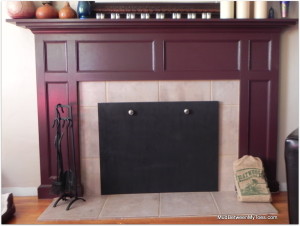
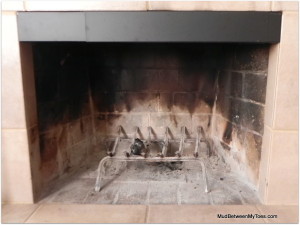
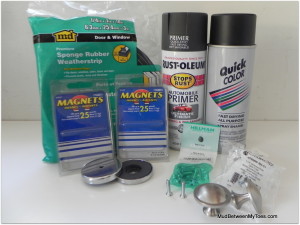
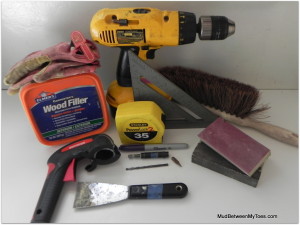
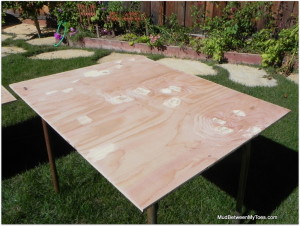
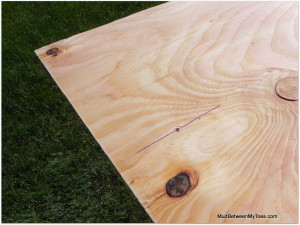
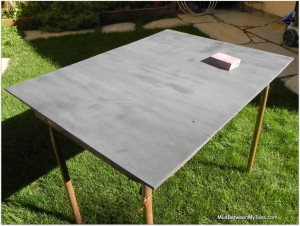
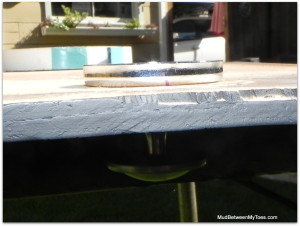

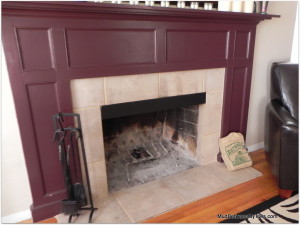

You need a great job and it looks real nice too. My problem is nothing I can see to attach a magnet to. There isn’t a smoke guard and no metal flu. It’s all brick and old inside. In fact, it leaks. I have a couple totes inside to collect the rain. I do have a guy that will eventually get here to seal it outside to prevent rain. I need it closed off for good inside so even knobs does not matter. BUT I am thinking for the most part, what you did, I could do IF I could figure out a way that it will not fall down. I could sit something in front of it but not sure the top would be secure enough. The main thing for now is to prevent losing heat up it this winter. Any more ideas, let me know. Thank you, best I have found for a do it yourself inexpensive cover.
Unfortunately, you’ve got a bigger problem than the cold air draft. The water leaking in means that you don’t have a chimney cap on the top of your chimney, the mortar between the bricks has failed, or both. A chimney cap (sometimes also called a spark arrester) generally cost $100 or less. They sit on top of the chimney and let smoke out, while preventing rain and critters from getting inside. This is a must-fix in your case, since that water intrusion is going to cause all kinds of problems (dry rot, mold, structural failure under the fireplace, etc.).
Next, we don’t know if you’ve got a chimney damper or not. Hopefully you do and the damper can be moved to the closed position. This should stop the air draft. I actually discovered (after I wrote this original blog post) that my damper had been installed incorrectly when the house was built. I had it completely replaced a few years ago and it solved most of my problems.
I strongly urge you to contact a local chimney sweep and ask them for their advice. They are chimney experts and will know the correct (and safest) way to fix your issue. Please be wary of anyone who just wants to seal off the top of the chimney – this can be dangerous. Read this link to learn more: https://fullservicechimney.com/how-to-block-a-chimney/
Best of luck to you!